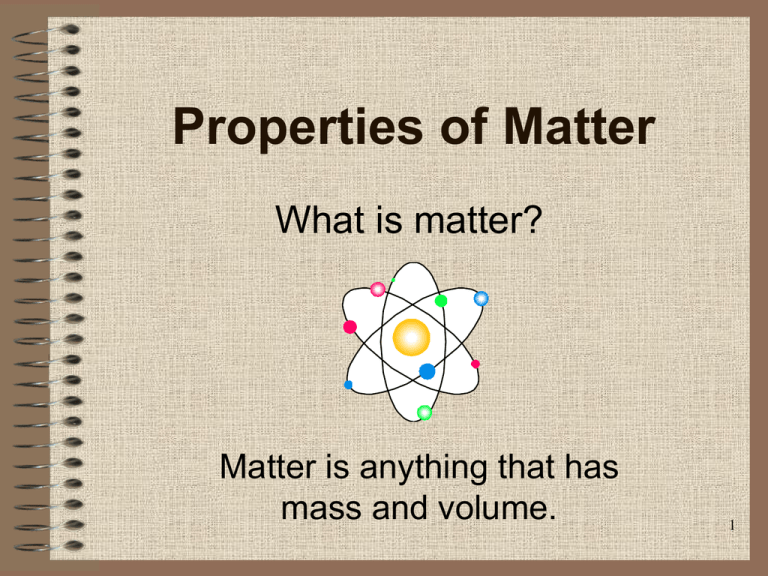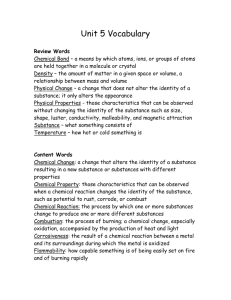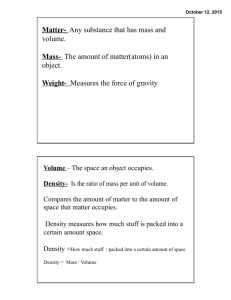Properties of Matter
advertisement

Properties of Matter What is matter? Matter is anything that has mass and volume. 1 Measuring Matter Volume of a liquid – Graduated cylinder- read from bottom of meniscus Volume of solid – Length X Width X Height Volume of Irregular Shaped Objects – Water Displacement Indirect Measuring – Large objects-take a core sample and use a formula – Small objects-weigh 100 and then divide weight by 100 to get one small objects weight 2 Classification of Matter MATTER Has mass and volume PHASES Solid, liquid, gas or plasma PROPERTIES PHYSICAL CHEMICAL MADE UP OF Element, compound or mixture 3 Phases of Matter SOLID, LIQUID, GAS, or PLASMA 4 Phases of Matter Solids - definite shape and volume Atoms are held close together by strong bonds Movement is slow Crystalline Solids (crystals) - atoms are arranged in regular fashion (geometric) • Ex. - ice, salt, diamonds Amorphous Solids - atoms LACK a regular arrangement • Ex. - rock, glass, wax 5 Phases of Matter - Continued Liquids - NO definite shape but definite volume Bonds are weaker and atoms are spaced apart They take the shape of container they are in Examples: oil, water, syrup, OJ, milk 6 Phases of Matter - Continued Gases - NO definite shape OR volume Bonds are weakest and atoms far apart Expands to fill the container they are in • Examples - air, oxygen, smoke 7 Phases of Matter - Continued Plasma • Gas like mixture of + and – charged particles Movement very rapid (10,000˚C) 99% of mass of our solar system Examples: Sun, Stars and Lightning 8 Classifying Matter • Physical Properties are those that can be observed without changing the identity of the substance • Chemical Properties are those that describe how a substance changes into other new substances 9 PROPERTIES OF MATTER PHYSICAL CHEMICAL • • • • • • • • • • • • Size Shape Texture Color Phase Conductor Ductile Malleable Shiny/luster Density Mass Tasteless Dissolves Odorless Hardness Brittle Tensile strength Fluid Viscosity Elasticity Buoyant Melting point Freezing point Boiling point • • • • • • • Flammability Changes color Reacts with Combustible Corrosive Volatile Explosive 10 Physical Properties of Matter • Viscosity – • Measure of the material’s resistance to flow • High-viscosity liquids take longer to flow • Example: Ketchup when comparing to water • Low-viscosity liquids flow easier • Example: Tomato Juice flows easier than ketchup • Temperature raising-viscosity decreases except in gases. 11 Physical Properties of Matter – Cont. • Elasticity – • Measure of ability to be stretched and then return to its original size. • Example:Rubber Bands, Elastic, and Playground Balls Question: Which ball would you rather play basketball? 12 Physical Properties of Matter – Cont. • Malleability – • Ability to be hammered into sheets • Example: Gold &Silver Coins, Aluminum Foil and Soda Cans 13 Physical Properties of Matter – Cont. • Brittleness – • measures a material’s tendency to shatter upon impact • Example: Sulfur, Calcium and Glass • Hardness – • Resistance to breaking or scratching • Example: diamonds 14 Physical Properties of Matter – Cont. • Luster – • shininess • Example: Gold, Silver, Mercury • Ductility – • ability to be pulled into wires • Example: Most metals (Copper, Silver) 15 Physical Properties of Matter – Cont. Tensile Strength• Measure of how much pulling, or tension, a material can withstand before breaking • Property of fibers, ropes, cables, girders • DuPont Kevlar-5 times tensile strength of steel 16 Physical Properties Melting Point – • Temperature at which a solid changes to a liquid • Example: Ice water Freezing Point – • Temperature at which a liquid changes to a solid • Example: Water Ice (0°C) 17 Physical Properties Boiling Point – • Temperature at which a liquid changes into a gas • Example: Water vapor (100˚ C) 18 Physical Properties of Matter – Cont. • Density – • The amount of mass in a given volume • How tightly packed the atoms or molecules are in a substance • Formula to calculate density is: Density = Mass Volume • Units are expressed as: • g/mL or g/L for liquids (remember the graduated cylinder) • g/cm3 for solids 19 Density of a Fluid Fluid• Any matter that is able to flow • Liquids and gases • Density of a liquid might be different from the density of the same solid • Most materials are denser in solid phase than their liquid phase • Exception- Water-freezes with air spaces so it is less dense and floats. • Density of liquid water is 1 g/ml 20 Physical Properties of Matter – Cont. • Buoyancy – • Upward force a fluid exerts on an object •Determines whether the object will sink or float • Example: Buoyancy of water keeping you afloat while swimming 21 Buoyancy Buoyancy force is LESS then object’s weight, object will SINK Buoyancy force is EQUAL to the object’s weight, object will FLOAT Buoyancy force is MORE then object’s weight, object will FLOAT IN AIR 22 Archimedes's Principle • Greek mathematician, 3rd century BC • Principle states-The buoyancy force on an object in a fluid is equal to the weight of the fluid displaced by the object Buoyancy of Gasses • Balloon floats because it displaces a very large volume of air • Volume of air displaced weighs more than the balloon 23 Classification of Matter MATTER Has mass and takes up space. SUBSTANCES Definite Composition ELEMENT Only 1 Kind of Atom COMPOUND Two or More Kinds of Atoms MIXTURES Variable Composition HOMOGENEOUS Solution evenly mixed HETEROGENEOUS Solution Unevenly mixed 24 Classification of Matter Matter can be divided into 2 categories: SUBSTANCES & MIXTURES • Substances can NOT be separated into different kinds of matter by physical means. • Mixtures can be separated into different kinds of matter by physical means. 25 Classification of Matter What are substances? In science, substances are limited to elements and compounds. – Elements • Any substance in which all the atoms in a sample are alike, one kind of matter • Examples: Carbon, Sodium and Oxygen – Compounds • 2 or more elements chemically combined in a fixed ratio (subscript) • Usually has different appearance from elements that make it up • Examples: Water – H2O and Salt - NaCl 26 Classification of Matter • Atom-smallest possible particle of an element • Molecule- smallest possible particle of a compound 27 Classification of Matter What are mixtures? 2 or more substances that can be separated by physical means Do not always contain the same amounts of the different substances that make them up –Homogeneous • same throughout, particles so tiny that cannot be seen, don’t settle out or scatter light • Examples: milk, salt water and cola –Heterogeneous • a mixture in which different materials can be easily distinguished •Suspension-visible particles settle-muddy water • Examples: Sand/water, Italian salad dressing, 28 pizza and dry soups Changes in Matter MATTER PHYSICAL CHANGES CHEMICAL CHANGES NUCLEAR CHANGES 29 Changes in Matter Physical • • • • • • • • Melting Freezing Boiling Evaporation Cutting Splitting Chopping Sublimation Chemical • • • • Chemical reaction Photosynthesis Respiration Digestion of food Nuclear •Fission •Fusion 30 Physical vs. Chemical Change Physical Change Does NOT create a new substance, affects only the physical properties. A change in size, shape or form (phases of matter). Appearance changes – not chemical makeup 31 Physical Change Vaporization• process at which a liquid changes to a gas by increasing the temperature to the liquids boiling point • Example: water boils to form steam at 100° C 32 Physical Change Evaporation• process at which a liquid changes to a gas. The liquid is not boiling. Example: A puddle drying up or sweat drying 33 Physical Change Condensation – • Process at which a gas becomes a liquid •Gas cooled below its boiling point • Example: water vapor water, dew in the morning, glass of ice tea in hot weather. 34 Physical change Sublimation – • When a solid changes directly to a gas •The matter doesn’t melt • Example:snow, dry ice and glaciers Deposition- •Gas changes directly into a solid •Ex. Fire extinguisher 35 Chemical Change Chemical Change A change in which a NEW substance is created End products are chemically different from the original. Corrosive-dissolving away of a metal-rusting 36 Four Signs or Evidence of a Chemical Change • • • • Gas forms Permanent color change Heat/or light energy is given off Precipitate forms. A precipitate is an insoluble substance that forms out of solution. 37 Physical vs. Chemical Change Identify the following as physical or chemical change. Ice cube melting. People eating. Wood burning. Slicing an apple into pieces. 38 Changes in Matter - Continued Exotic Super Hot • Nucleus of atom comes apart • Particle accelerates Exotic Super Cold • Below -270˚ C • Superfluids from gases 39 Charles’ Law Jacques Charles, French scientist (1742-1823) • Law states-volume of a gas increases when temperature increases and reverse, volume of gas decreases when temperature decreases. • V1 / T1 = V2 / T2 – Temperature must be in Kelvin degrees (+273) 40 Boyle’s Law Robert Boyle-British scientist (1627-1691) • Law states-as pressure of a gas increases, its volume decreases proportionately and reverse pressure of gas decreases, its volume increases proportionately. • P1 V1 = P2 V2 • Pascal-unit for pressure (Pa) (kPa) 41





